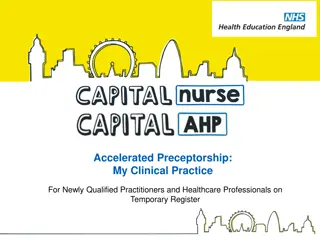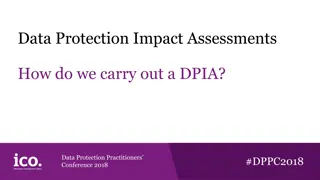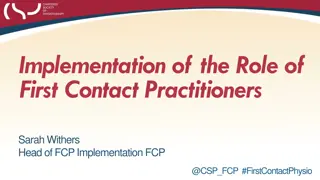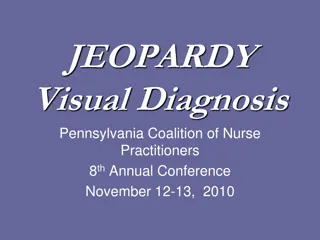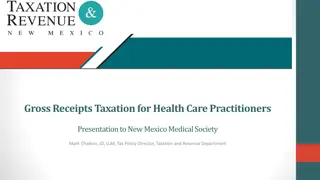General Practitioners medibus
General practitioners show low familiarity with NHRMC Infant Feeding Guidelines 2013, particularly regarding protein intake and its association with later obesity. Many are unsure about recommended protein levels and formula choices for infants. Insights from a study conducted in October 2014 shed light on the gaps in knowledge among GPs in this critical area of infant care.
Uploaded on Feb 22, 2025 | 0 Views
Download Presentation

Please find below an Image/Link to download the presentation.
The content on the website is provided AS IS for your information and personal use only. It may not be sold, licensed, or shared on other websites without obtaining consent from the author.If you encounter any issues during the download, it is possible that the publisher has removed the file from their server.
You are allowed to download the files provided on this website for personal or commercial use, subject to the condition that they are used lawfully. All files are the property of their respective owners.
The content on the website is provided AS IS for your information and personal use only. It may not be sold, licensed, or shared on other websites without obtaining consent from the author.
E N D
Presentation Transcript
General Practitioners medibus October 2014
Key Findings A generally low familiarity with NHRMC Infant Feeding Guidelines 2013 is seen among general practitioners, with a majority of them being vaguely familiar or not at all familiar with it. GPs are not strongly convinced that excessive protein intake is associated with obesity only 6% completely agree while half of the doctors take a neutral standpoint. A protein level of 2.2 g per 100 kcal is perceived to be a moderate level. A protein level of 1.9 g per 100 kcal is thought to be lower than or same as mature breast milk. Moreover, a quarter of GPs think this level may not meet the infant s protein needs. The majority of GPs are unsure of the decrease in protein levels in breast milk over time and the discrepancies between reference of breastmilk and the current norms for infant formula.
Familiarity with NHRMC guidelines is generally low, the majority are vaguely familiar or not at all familiar Familiarity with the NHRMC Infant Feeding Guidelines 2013 45% 36% 32% 28% 30% 15% 4% Less than 1% 0% Extremely familiar Very familiar Moderately familiar Slightly familiar Not at all familiar Extremely familiar Very familiar Moderately familiar Slightly familiar Not at all familiar Significantly higher vs. Female GPs Male ( n = 125) 0% 2% 22% 33% 43% Female (n = 75) 1% 5% 40% 31% 23% Base: 200 General Practitioners Q1: How familiar are you with the NHRMC Infant Feeding Guidelines 2013?
GPs are not strongly convinced that excessive protein intake is associated with obesity, 50% are on the fence Excessive protein intake in early infancy is associated with later obesity 60% 50% 45% 35% 30% 15% 9% 6% Less than 1% 0% Completely agree Somewhat agree Neither agree nor disagree Somewhat disagree Completely disagree Base: 200 General Practitioners Q2: The updated NHRMC Infant Feeding Guidelines 2013 recommend using a lower protein formula for infants that are not breastfed, as there is mounting evidence that excessive protein intake in early infancy is associated with later obesity. To what extent do you agree that excessive protein intake in early infancy is associated with later obesity?
A protein level of 2.2 g per 100 kcal is seen as medium while 1.9 g is lower than or same as mature breast milk Follow-on formula with a protein level of 2.2 g per 100 kcal is: Follow-on formula with a protein level of 1.9 g per 100 kcal is: 90% 79% May not meet the infants protein needs 80% 25% 70% 60% Lower than or the same as mature breast milk protein 55% 50% 40% Higher than protein concentration of mature breast milk 18% 30% 13% 20% 8% Higher than protein concentration of mature breast milk AND may not meet the infants protein needs 10% 2% 0% High Medium Low 0% 10% 20% 30% 40% 50% 60% Base: 200 General Practitioners Base: 200 General Practitioners Q5: If a follow-on formula had a protein level of 2.2g per 100 kcal, would you say that is: Q6: If a follow-on formula had a protein level of 1.9g per100kcal, would you say that is:
The majority of GPs are unsure of protein level decrease over time and discrepancy between references Protein levels in breast milk decrease over time from the first to 12th month of breast feeding There is no discrepancy between the reference of breastmilk and the current norms for infant formula 11% 30% 30% True False Not sure True False Not sure 59% 63% 7% Base: 200 General Practitioners Base: 200 General Practitioners Q7: Protein levels in breast milk decrease over time from the first to 12th month of breast feeding. Q8: There is no discrepancy between the reference of breastmilk and the current norms for infant formula
Discrepancies between the reference breastmilk and the current norms for infant formula Protein levels and fat content Easy to digest Breastmilk varies in composition over time so this will be a discrepancy to fixed protein level formula More natural proteins in breast milk More fat and less protein on breast milk Breastmilk concentrations will change over time and depending on mothers health/diet. The formula will not. Breast milk contains less protein than normal formula milk, perhaps half the amount. Breast milk has more oligosaccharides, omega-3 Breast milk has specific protein easily digestible Human milk - soft, easily-digestible whey - more completely absorbed Breast milk's components are easily digested by a newborn's immature system Breastmilk has protein that is easier to digest. It also has probiotics and other vitamins that not in formula. fats, immune and growth factors. Breastmilk is best Antibodies Breastmilk is superior. Breast milk has mother's antibodies present Formula is not equivalent to breast milk No formula is identical to breast milk Breast milk is better , always give breast milk Maternal antibodies Infant formulas may have all the components in various entities of the protein, fat and carbohydrate but miss the breast milk antibodies. In breastmilk besides carbohydrates, proteins and other essentials there are antibodies, whereas in infant formula there are none. if possible Breastmilk is best Immune protection Base: 59 General Practitioners who think there are discrepancies between the reference of breast milk and the current norms for infant formula Q9: Please specify the discrepancies between the reference of breastmilk and the current norms for infant formula:
Methodology and demographics Quota Sample # Sample % Population % Male 125 62% 67% All interviews completed between 06/10/2014 and 13/10/2014. Female 75 38% 33% 50 years 105 52% 43% > 50 years 95 48% 57% NSW / ACT 69 35% 35% VIC / TAS 57 28% 27% Sample of 200 GPs from Cegedim s panel of healthcare professionals. QLD / NT 41 20% 19% WA / SA 33 16% 19% 57 28% 19% 100 patients per week 101 200 patients per week 124 62% 63% Statistically significant differences calculated at 95% confidence level, indicated with or . 19 10% 18% 201 patients per week Total 200 100% 100%
Cegedim Group in Australia OneKey Promotion Audit OK PA Mobile Intelligence Prescribing Data MI PD Direct Marketing Market Research DM MR Patient Support KOL profiling PS KOL Lianne Palo| Research Manager | 02 9855 7984 | lianne.palo@cegedim.com Kai Meischke | Sales and Marketing Manager | 02 9855 7972| kai.meischke@cegedim.com






